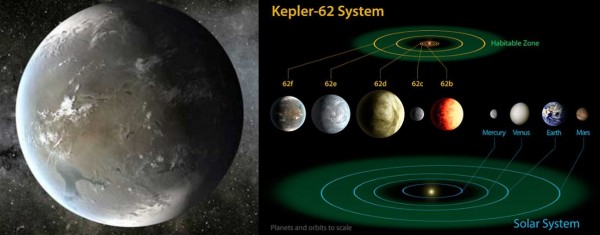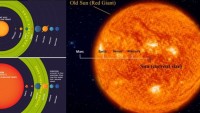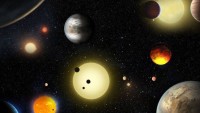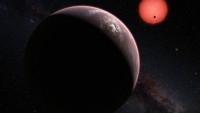Super-Earth Exoplanet Kepler-62f has Oceans and Probably Life
| Arthur Dominic Villasanta | | May 28, 2016 09:46 AM EDT |
(Photo : NASA) Kepler-62f and its solar system compared to ours
It turns out Kepler-62f, a super-Earth exoplanet 370 parsecs away thought to have surface water when it was discovered in 2013, might really be a water-dominated solid planet with life.
Kepler-62f heads to the top of the list of exoplanets that might have life - most probably microorganisms - in its oceans. Apart from Kepler-62f, Kepler-186f and Kepler-442b are the best candidates for potentially habitable planets.
Like Us on Facebook
What makes Kepler-62f a more likely candidate for life however primitive are its physical characteristics.
It's located inside the habitable or Goldilocks zone of its star, Kepler-62. It's also a massive planet 40 percent larger than the Earth and that, said scientists, is a good indication Kepler-62f is a solid planet and not a gas giant. A previous study showed that a great majority of planets in its size range are completely covered by oceans.
Kepler-62f is the outermost of five planets orbiting a star smaller and cooler than our Sun. It might also have a moon.
"We found there are multiple atmospheric compositions that allow it to be warm enough to have surface liquid water," said Aomawa Shields, lead author of the study published online in the journal Astrobiology.
"This makes it a strong candidate for a habitable planet."
Shields also noted that at its size, Kepler-62f is within the range of planets likely to be rocky and could possibly have oceans. The study was conducted by scientists at the University of California-Los Angeles and the University of Washington.
To find-out if Kepler-62f could sustain life, the team drew-up scenarios about what its atmosphere might be like and what the shape of its orbit might be.
It found there are multiple atmospheric compositions that allow Kepler-62f to be warm enough to have surface liquid water. It also conducted computer simulations and found many scenarios that allow the planet to be habitable, assuming different amounts of carbon dioxide in its atmosphere.
Shields said that for the planet to be consistently habitable throughout its entire year, it would require an atmosphere three to five times thicker than Earth's and composed entirely of carbon dioxide.
Having such a high concentration of carbon dioxide would be possible for the planet because CO2 could build up in the planet's atmosphere as temperatures get colder to keep the planet warm.
Shields collaborated with astronomers Rory Barnes, Eric Agol, Benjamin Charnay, Cecilia Bitz and Victoria Meadows, all of the University of Washington.
©2015 Chinatopix All rights reserved. Do not reproduce without permission
EDITOR'S PICKS
-

Did the Trump administration just announce plans for a trade war with ‘hostile’ China and Russia?
-

US Senate passes Taiwan travel bill slammed by China
-

As Yan Sihong’s family grieves, here are other Chinese students who went missing abroad. Some have never been found
-

Beijing blasts Western critics who ‘smear China’ with the term sharp power
-

China Envoy Seeks to Defuse Tensions With U.S. as a Trade War Brews
-

Singapore's Deputy PM Provides Bitcoin Vote of Confidence Amid China's Blanket Bans
-

China warns investors over risks in overseas virtual currency trading
-

Chinese government most trustworthy: survey
-

Kashima Antlers On Course For Back-To-Back Titles
MOST POPULAR
LATEST NEWS
Zhou Yongkang: China's Former Security Chief Sentenced to Life in Prison

China's former Chief of the Ministry of Public Security, Zhou Yongkang, has been given a life sentence after he was found guilty of abusing his office, bribery and deliberately ... Full Article
TRENDING STORY

China Pork Prices Expected to Stabilize As The Supplies Recover

Elephone P9000 Smartphone is now on Sale on Amazon India

There's a Big Chance Cliffhangers Won't Still Be Resolved When Grey's Anatomy Season 13 Returns

Supreme Court Ruled on Samsung vs Apple Dispute for Patent Infringement

Microsoft Surface Pro 5 Rumors and Release Date: What is the Latest?














